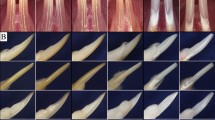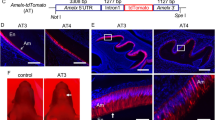Abstract
A heterogeneous mixture of amelogenins can be extracted from developing tooth enamel matrix. In an attempt to discover the extent to which alternative splicing of the amelogenin primary RNA transcript can generate unique isoforms, we have conducted a thorough search for cDNAs amplified by reverse transcription-polymerase chain reaction (RT-PCR). Over 2400 colonies were screened by colony hybridization. Seven different alternatively spliced amelogenin mRNAs were isolated. The predicted translation products of the messages are 194, 180, 156, 141, 74, 59, and 44 amino acids in length. RT-PCR amplification products not predicted by these seven amelogenin cDNAs were characterized. The intron separating exons 5 and 6 was cloned and sequenced. Using rapid amplification of cDNA ends (RACE) techniques, the 5′ ends of the amelogenin mRNAs were cloned and characterized. The finding that the same exon 1 is common to all of the cloned mRNAs indicates that mouse amelogenin is transcribed from a single promoter. The mouse amelogenin transcription and translation initiation sites, the 5′ untranslated leader, and the segment encoding the signal peptide were determined. The distinctly nonamelogenin-like exon 4, first observed in human amelogenin cDNAs, has also been found in mice. Antibodies were raised to synthetic exon 4-encoded polypeptides and used to immunostain Western transfers and histologic tooth sections.
Similar content being viewed by others
References
Deutsch D (1989) Structure and function of enamel gene products. Anat Rec 224:189–210
Termine JD, Belcourt AB, Christner PJ, Conn KM, Nylen MU (1980) Properties of dissociatively extracted fetal tooth matrix proteins. J Biol Chem 255:9760–9768
Lau EC, Mohandas T, Shapiro LJ, Slavkin HC, Snead ML (1989) Human and mouse amelogenin gene loci are on the sex chromosomes. Genomics 4:162–168
Chapman VM, Keitz BT, Disteche CM, Lau EC, Snead ML (1991) Linkage of amelogenin (Amel) to the distal portion of the mouse X chromosome. Genomics 10:23–28
Fincham AG, Bessem CC, Lau EC, Pavlova Z, Shuler C, Slavkin HC, Snead ML (1991) Human developing enamel proteins exhibit a sex-linked dimorphism. Calcif Tissue Int 48:288–290
Nakahori Y, Takenaka O, Nakagome Y (1991) A Human X-Y homologous region encodes “amelogenin”. Genomics 9:264–269
Salido EC, Yen PH, Koprivnikar K, Yu L-C, Shapiro LJ (1992) The human enamel protein gene amelogenin is expressed from both the X and Y chromosomes. Am J Hum Genet 50:303–316
Sasaki S (1984) Proc of the 4th Int Symp on the composition, properties and fundamental structure of tooth enamel and related tissues. Fearnhead RW, Suga S (eds) Elsevier Science Publishers, Excerpta Medica, Amsterdam, p 201
Gibson CW, Golub E, Ding W, Shimokawa H, Young M, Termine J, Rosenbloom J (1991) Identification of the leucine-rich amelogenin peptide (LRAP) as the translation product of an alternatively spliced transcript. Biochem Biophys Res Commun 174:1306–1312
Yamakoshi Y, Tanabe T, Fukae M, Shimizu M (1994) Porcine amelogenins. Calcif Tissue Int 54:69–75
Gibson CW, Golub EE, Herold R, Risser M, Ding W, Shimokawa H, Young M, Termine J, Rosenbloom J (1992) Structure and expression of the bovine amelogenin gene. Biochemistry 30:1075–1079
Gibson CW, Golub EE, Abrams WR, Shen G, Ding W, Rosenbloom J (1992) Structure and expression of the bovine Y-chromosomal amelogenin gene. In: Slavkin HC, Price P (eds) Chemistry and biology of mineralized tissues. Elsevier Scientific Publishers, Amsterdam, pp 125–131
Lau EC, Simmer JP, Bringas P Jr, Hsu D, Hu C-C, Zeichner-David M, Thiemann F, Snead ML, Slavkin HC, Fincham AG (1992) Alternative splicing of mouse amelogenin RNA transcript: a major contributor to producing amelogenin heterogeneity. Biochem Biophys Res Commun 118:1253–1260
Couwenhoven RI, Snead ML (in press) Early determination and permissive expression of amelogenin transcription during mouse mandibular first molar development. Dev Biol
Sambrook, J, Fritsch EF, Maniatis T (1989) Molecular cloning: a laboratory manual, 2nd ed. Cold Spring Harbor Lab. Press, New York
Davis LG, Dibner MD, Battey JF (1986) Guanidine isothiocyanate preparation of total RNA. In: Basic methods in molecular biology. Elsevier Science Publishers, New York, pp 130–135
Titus DE (ed) (1991) Promega protocols and applications guide, pp 95–97
Tam (1988) Proc Natl Acad Sci USA 85:5409
Altschul SF, Gish W, Miller W, Myers EW, Lipman DJ (1990) Basic local alignment search tool. J Mol Biol 215:403–410
Kozak M (1983) Compilation and analysis of sequences upstream from the translational start site in eukaryotic mRNAs. Nucleic Acids Res 12(2):857–872
Kozak M (1986) Point mutations define a sequence flanking the AUG initiator codon that modulates translation by eukaryotic ribosomes. Cell 44:283–292
Gierasch LM (1989) Signal sequences. Biochemistry 28(3):923–930
Zorn AM, Krieg PA (1991) PCR analysis of alternative splicing pathways: identification of artifacts generated by heteroduplex formation. BioFeedback 11(2):181–182
Niklas-Dahl LM, Nakahori Y, Nakagome Y, Backman B, Landegren U, Pettersson U (1991) A deletion in the amelogenin gene (AMG) causes X-linked amelogenesis imperfecta (AIH1). Genomics 10:971–975
Aldred MJ, Crawford PM, Roberts E, Thomas NST (1992) Identification of a nonsense mutation in the amelogenin gene (AMELX) in a family with X-linked amelogenesis imperfecta (AIH1). Hum Genet 90:413–416
Fincham AG, Lau EC, Simmer JP, Zeichner-David M (1992) Amelogenin biochemistry—form and function. In: Slavkin HC, Price P (eds) Chemistry and biology of mineralized tissues. Elsevier Scientific Publishers, Amsterdam, pp 187–202
Samachson J (1969) Basic requirements for calcification. Nature 221:147–1248
Eastoe J (1989) Tooth Enamel V. In: Fearnhead RW (ed) Florence Publishers, Yokahama, Japan, p 89
Simmer JP, Lau EC, Hu C-C, Aoba T, Lacey M, Nelson D, Zeichner-David M, Snead ML, Slavkin HC, Fincham AG (1994) Isolation and characterization of a mouse amelogenin expressed in Escherichia coli. Calcif Tissue Int 54:312–319
Aoba T, Moreno EC (1987) The enamel fluid in the early secretory stage of porcine amelogenesis: chemical composition and saturation with respect to enamel mineral. Calcif Tissue Int 41:86–94
Glimcher MJ (1979) Phosphopeptides of enamel matrix. J Dent Res 58B:790–806
Aoba T, Tanabe T, Moreno EC (1987) Function of amelogenins in porcine enamel mineralization during the secretory stage of amelogenesis. Adv Dent Res 1(2):252–260
Aoba T, Fukae M, Tanabe T, Shimizu M, Moreno EC (1987) Selective adsorption of porcine-amelogenins onto hydroxyapatite and their inhibitory activity on hydroxyapatite growth in supersaturated solutions. Calcif Tissue Int 41:281–289
Eastoe JE (1960) Nature (London) 187:411–412
Warshawsky H (1989) In: Fearnhead (ed) Tooth enamel V. Yohohama, p 252
Snead ML, Luo W, Lau EC, Slavkin HC (1988) Spatial-and temporal-restricted pattern of amelogenin gene expression during mouse molar tooth organogenesis. Development 104:77–85
Luo W, Slavkin HC, Snead ML (1991) Cells from Hertwig's epithelial root sheath do not transcribe amelogenin. J Perio Res 26:42–47
Slavkin HC, Bessem C, Bringas P Jr, Zeichner-David M, Nanci A, Snead ML (1988) Sequential expression and differential function of multiple enamel proteins during fetal, neonatal, and early postnatal stages of mouse molar organogenesis. Differentiation 37:26–39
Nanci A, Ahluwalia JP, Pompura JR, Smith CE (1989) Biosynthesis and secretion of enamel proteins in the rat incisor. Anat Rec 224:277–291
Smith CE, Nanci A (1989) Secretory activity as a function of the development and maturation of ameloblasts. Connect Tissue Res 22:147–156
Nanci A, Slavkin HC, Smith CE (1987) Immunocytochemical and radioautographic evidence for secretion and intracellular degradation of enamel proteins by ameloblasts during the maturation stage of amelogenesis in rat incisors. Anat Rec 217:107–123
Gilbert W (1978) Why genes in pieces? Nature 271:501
Briggs MM, Schachat R (1993) Origin of fetal troponin T: developmentally regulated splicing of a new exon in the fast troponin T gene. Dev Biol 158:503–509
Ushiyama S, Laue TM, Moore KL, Erickson HP, McEver RP (1993) Structural and functional characterization of monomeric soluble P-selectin and comparison with membrane P-selectin. J Biol Chem 268(20):15229–15237
Namba T, Sugimoto Y, Negishi M, Irie A, Sshikubi F, Kakizuka A, Ito S, Ichikawa A, Narumiya S (1993) Alternative splicing of C-terminal tail of prostaglandin E receptor subtype EP3 determines G-protein specificity. Nature 365:166–170
Spengler D, Waeber C, Pantaloni C, Holsboer F, Bockaert J, Seeburg PH, Journot L (1993) Differential signal transduction by five splice variants of the PACAP receptor. Nature 365:170–175
Yan G, McBride G, McKeehan WL (1993) Exon skipping causes alteration of the COOH-terminus and deletion of the phospholipase Cg1 interaction site in the FGF receptor 2 kinase in normal prostate epithelial cells. Biochem Biophys Res Commun 194(1):512–518
Hsu T, Gogos JA, Bolton J, Kafatos FC (1993) Alternatively spliced isoforms of a Cis2-His2 Zinc-finger domain. Ann NY Acad Sci 684:218–219
Gogos JA, Hsu T, Bolton J, Kafatos FC (1992) Sequence discrimination by alternatively spliced isoforms of a DNA binding zinc finger domain. Science 257:1951–1955
Sorimachi H, Ishiura S, Suzuki K (1993) A novel tissue-specific Calpain species expressed predominantly in the stomach comprises two alternative splicing products with and without Ca2+ binding domain. J Biol Chem 268(2):19676–19482
Gilbert E, Gatto FD, Champion-Arnaud P, Gesnel M-C, Breathnach R (1993) Control of BEK and K-SAM splice sites in alternative splicing of the fibroblast growth factor receptor 2 pre-mRNA. Mol Cell Biol 13(9):5461–5468
Tingley WG, Roche KW, Thompson AK, Huganir RL (1993) Regulation of NMDA receptor phosphorylation by alternative splicing of the C-terminal domain. Nature 364:70–73
Otterson Ga, Kratzke RA, Lin AY, Johnston PG, Kay FJ (1993) Alternative splicing of the RBP1 gene clusters in an internal exon that encodes potential phosphorylation sites. Oncogene 8(4):949–957
Durand GM, Bennett MVL, Zukin S (1993) Splice variants of the N-methyl-D-aspartate receptor NR1 identify domains involved in regulation by polyamines and protein kinase C. Proc Natl Acad Sci USA 90:6731–6735
De la Pena P, Delgado LM, del Camino D, Barros F (1992) Two isoforms of the thyrotropin-releasing hormone receptor generated by alternative splicing have indistinghuishable functional properties. J Biol Chem 267(36):25703–25708
Krainer AR, Mayeda A, Kozak D, Bins G (1991) Functional expression of cloned human splicing factor SF2: homology to RNA-binding proteins, U1 70K, and Drosophila splicing regulators. Cell 66:383–394
Ge H, Zuo P, Manley JL (1991) Primary structure of the human splicing factor ASF reveals similarities with Drosophila regulators. Cell 66:373–382
Diamond RH, Du K, Lee VM, Mohn KL, Haber BA, Tewari DS, Taub R (1993) Novel delayed-early and highly insulin-induced growth response genes. J Biol Chem 268:15185–15192
Magnuson VL, Young M, Schattenberg DG, Mancini MA, Chen DL, Steffensen B, Klebe RJ (1991) The alternative splicing of fibronectin pre-mRNA is altered during aging and in response to growth factors. J Biol Chem 266(22):14654–14662
Terry RW, Kwee L, Levine JF, Labow MA (1993) Cytokine induction of an alternatively spliced murine vascular cell adhesion molecule (VCAM) mRNA encoding a glycosylphosphatidylinositol-anchored VCAM protein. Proc Natl Acad Sci USA 90:5919–5923
Collett JW, Stele RE (1993) Alternative splicing of a neural-specific Src mRNA (Src +) is a rapid and protein synthesis-independent response to neural induction in Xenopus laevis. Dev Biol 158:487–495
Pan JB, Monteggia LM, Giordano T (1993) Altered levels and splicing of the amyloid precursor protein in the adult rat hippocampus after treatment with DMSO or retinoic acid. Brain Res 18(3):259–266
Fincham AG, Hu Y, Lau EC, Slavkin HC, Snead ML (1991) Amelogenin post-secretory processing during biomineralization in the postnatal mouse molar tooth. Arch Oral Biol 36:305–317
Morisaki H, Morisaki T, Newby LK, Holmes EW (1993) Alternative splicing: a mechanism for phenotypic rescue of a common inherited defect. J Clin Invest 91(5):2275–2280
Aldred MJ, Crawford PM, Roberts E, Thomas NST (1992) Identification of a nonsense mutation in the amelogenin gene (AMELX) in a family with X-linked amelogenesis imperfecta (AIH1). Hum Genet 90:413–416
Limeback H, Simic A (1990) Biochemical characterization of stable high molecular-weight aggregates of amelogenins formed during porcine enamel development. Arch Oral Biol 35(6):459–468
Author information
Authors and Affiliations
Rights and permissions
About this article
Cite this article
Simmer, J.P., Hu, C.C., Lau, E.C. et al. Alternative splicing of the mouse amelogenin primary RNA transcript. Calcif Tissue Int 55, 302–310 (1994). https://doi.org/10.1007/BF00310410
Received:
Accepted:
Issue Date:
DOI: https://doi.org/10.1007/BF00310410




